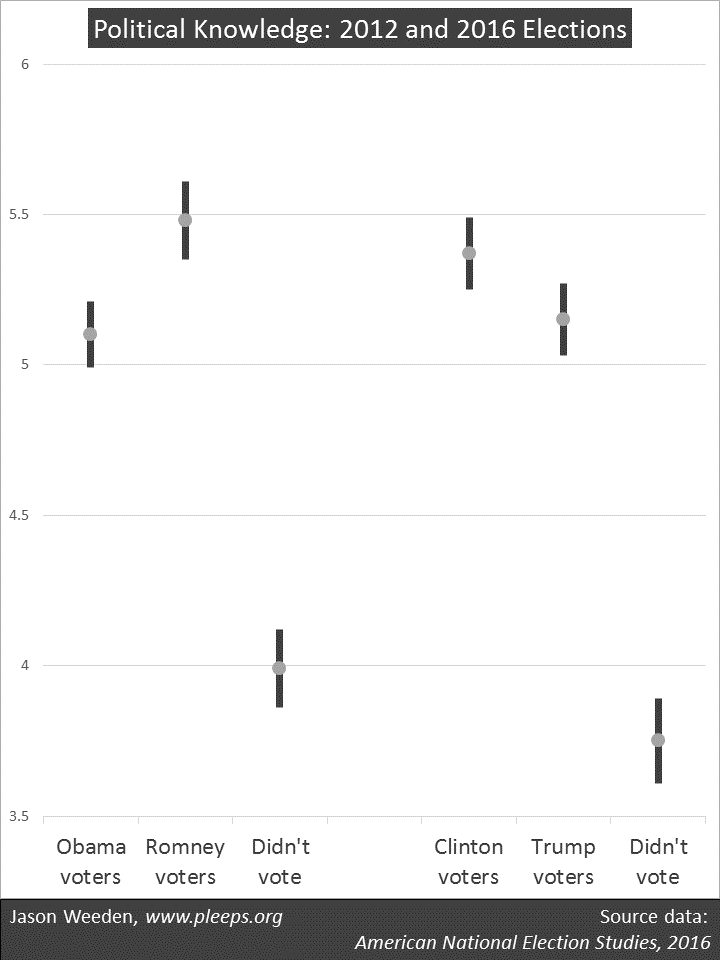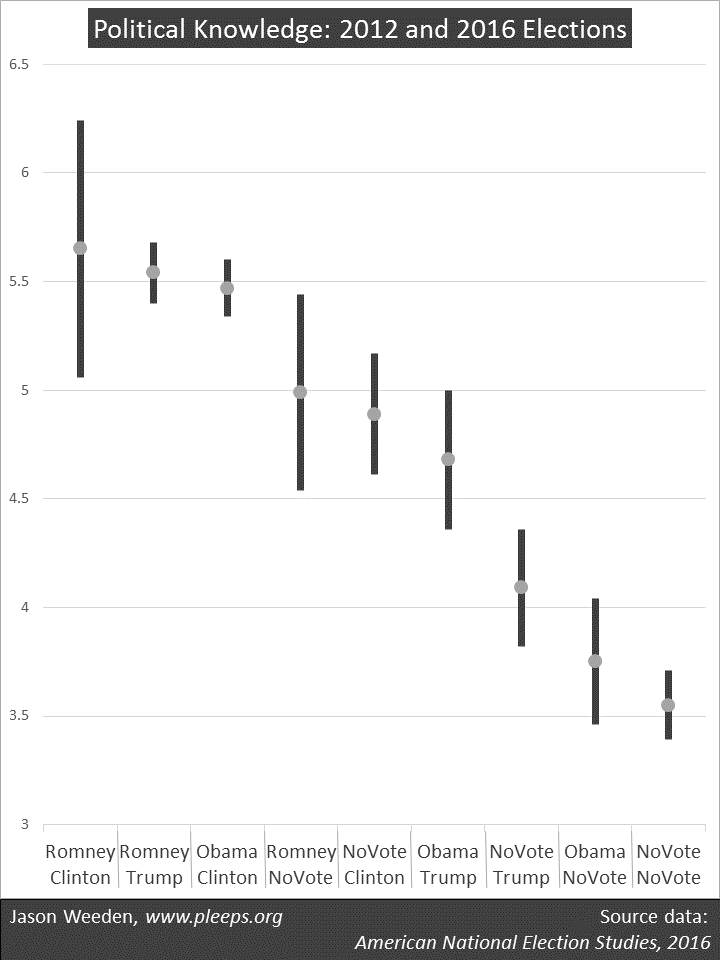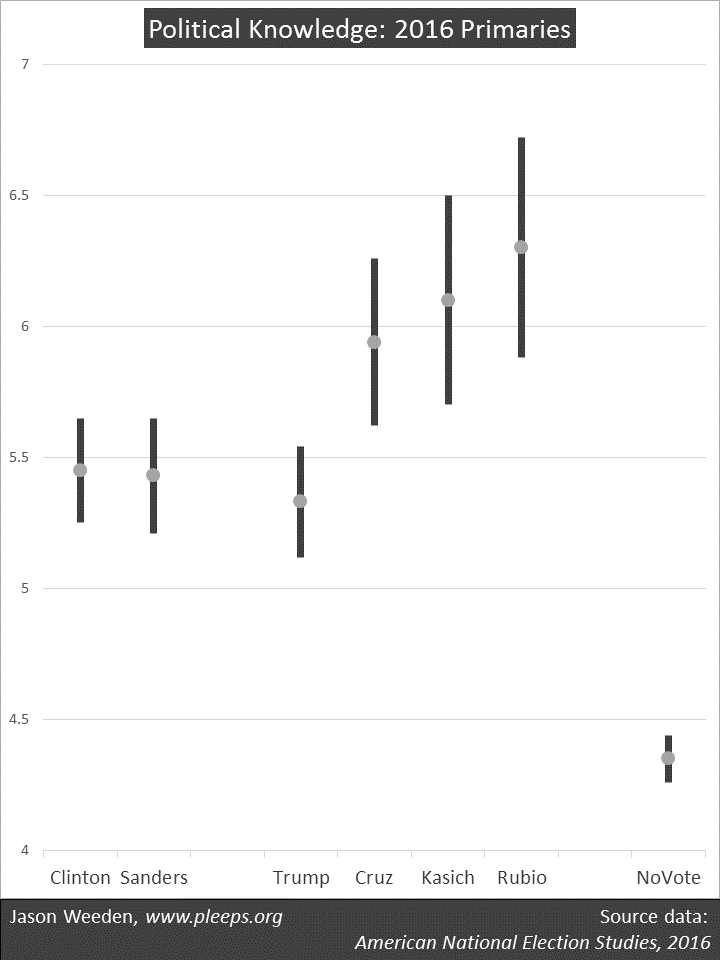But she probably would have been running against President Romney, and might have still lost.
Epistocracy is in essence the idea that voting participation or outcomes should be adjusted relative to citizens’ knowledge levels. For example, perhaps people should have to pass a basic political knowledge test before being allowed to vote, or perhaps we should allocate extra votes to people who do particularly well on such tests.
In a post last year, I took the 2016 exit polls, along with political knowledge test results from the 2012 American National Election Studies (ANES), and tried to estimate how various epistocracy proposals would have affected the 2016 presidential race between Clinton and Trump. It was complicated work, estimating party- and demographic-specific knowledge levels from the 2012 sample, and seeing how that would plug into the demographic voting patterns from the 2016 exit polls.
My conclusion was that various epistocracy proposals would have helped Trump. But the new 2016 ANES sample was recently released. And now it seems likely that my conclusion was wrong.
There’s no need for a complicated model this time. The 2016 ANES survey included nine political knowledge items (e.g., knowing which party controlled the U.S. House and Senate and being able to identify various domestic and foreign leaders). It asked people how they voted in the 2012 and 2016 presidential elections. So, you know, we can just look within the same sample at Obama vs. Romney voters and Clinton vs. Trump voters regarding how well they did on the nine-item test of political knowledge.
The chart below shows the main results, including political knowledge averages (the dots) and 95% confidence intervals (the lines). Looking at 2012, according the the 2016 ANES sample, Obama voters averaged 5.1 correct out of the 9 items measuring political knowledge, while Romney voters averaged 5.48. This was a highly significant difference (p = .00001); you can see that the 95% confidence intervals are pretty far apart. In 2016, in contrast, Clinton voters averaged 5.37, while Trump voters averaged 5.15. This was a smaller knowledge gap than in 2012, though still significant (p = .009); you can see that the 95% confidence intervals overlap a bit.
So, the headline here is that various epistocracy proposals likely would have helped Clinton over Trump. But such proposals would have especially helped Romney over Obama. (In fact, before anyone on the left gets too mouthy about the average political knowledge of Trump voters, they should note that the 2016 ANES data suggest that Trump voters were at least as knowledgeable on average as Obama voters.) And it’s entirely more difficult to say what the implications would have been for a contest pitting President Romney against challenger Clinton in 2016, though the ANES sample suggests that epistocracy proposals would have perhaps given a small boost to Romney.
OK, so how did this happen? What did my earlier estimates miss? What changed such that, in the 2016 ANES sample, we see substantially higher political knowledge for Romney voters relative to Obama voters, but then things flip in the Clinton-Trump race?
Changes from 2012 to 2016
There are at least a couple of basic things that caused my earlier analysis to differ from the results in the 2016 ANES sample. One, as I discussed in yesterday’s post, is that the 2016 exit polls have some substantial differences with the 2016 ANES sample. For example, relative to the ANES data, the exit polls contain a lot more college-educated folks, show a weaker pro-Clinton margin among the college-educated, and show a wider gender gap. In short, I checked what the 2016 ANES political knowledge outcomes would look like if the ANES sample mirrored the demographic composition of the exit polls, and Clinton’s epistocracy advantage would be reduced but not eliminated. In addition, the 2016 ANES data show marginally smaller racial and gender gaps in political knowledge than did the 2012 ANES, so that was part of it as well.
But the bigger impact comes from what the 2016 ANES sample shows about differences in turnout between 2012 and 2016. The new data suggest that two complementary things happened: A group of especially low-knowledge folks who had turned out for Obama ended up sitting out the 2016 election, while at the same time a different group of especially low-knowledge folks who had sat out the 2012 election ended up turning out for Trump. This raised the average political knowledge of Clinton voters relative to Obama voters and lowered the average political knowledge of Trump voters relative to Romney voters, something that went beyond what the basic demographics in the 2016 exit polls suggested.
As I discussed in a recent post, the 2016 ANES data show a lot of complex shifts from 2012 to 2016. These dynamics involved not only (or even primarily) voters switching between parties, but also (in fact, mainly) switches between voting and not voting.
The chart below shows averages in the nine-point political knowledge measure, split out by both 2012 and 2016 major-party votes (and non-votes).
- There are three groups with pretty high knowledge averages: People who voted Romney and then switched to Clinton (though this is a pretty small group, which shows up in the wide 95% confidence intervals represented by the line), people who voted for Romney and then Trump, and people who voted for Obama and then Clinton.
- And then there are three groups in the middle: People who voted for Romney and then didn’t vote for president in 2016, people who didn’t vote in 2012 and then voted for Clinton, and people who voted for Obama and then switched to Trump.
- And then there are three groups with particularly low political knowledge averages: People who didn’t vote in 2012 and then voted for Trump, people who voted for Obama and then didn’t vote in 2016, and people who sat out both the 2012 and 2016 presidential elections.
Thus, you can see what I’m talking about at the low end of the chart. There was a group of low-knowledge Obama voters who didn’t turn out in 2016. And there was also a different group of low-knowledge Trump voters who hadn’t turned out in 2012. These groups have substantially lower political knowledge on average than both the Romney voters who didn’t turn out in 2016 and the Clinton voters who hadn’t turned out in 2012. It was these turnout dynamics that primarily drove the flip in the major parties’ political knowledge averages between 2012 and 2016.
As I’ve mentioned, these kinds of patterns might spell trouble in the 2018 midterms for Republicans. Just as Obama had personally attracted a segment of low-knowledge folks who don’t normally turn out and couldn’t be relied on in midterms, we now have indications that Trump also personally attracted his own (different) segment of unreliable, low-knowledge folks.
Political knowledge and the primaries
The 2016 ANES data provide a look at the primaries as well. The chart below shows political knowledge averages for the major contestants’ voters in the primaries (and also shows the lower average of people who didn’t vote in the primaries).
Would epistocracy proposals have affected the Clinton-Sanders primary race? It doesn’t look like it. Would epistocracy proposals have hurt Trump in the Republican primaries? Yes, it’s likely. This isn’t, though, because Trump’s primary voters were especially low-knowledge—they weren’t significantly lower than Clinton’s and Sanders’s primary voters. Instead, it’s because the other Republican primary voters were especially high in political knowledge.
These patterns reinforce a couple of earlier points. First, political knowledge is higher among people who regularly vote. And, second, typical Republican voters (whether voting for Romney in 2012 or for Cruz, Kasich, or Rubio in the 2016 primaries) do better on political knowledge tests than typical Democratic voters.
As usual, it’s complicated
So there are various ways that epistocracy might have stopped Trump in 2016. If there had been some significant epistocracy mechanism in the 2012 general election, then it’s likely that Romney would have won, and, under the usual assumptions, unlikely that Trump would or could have mounted a successful Republican primary challenge to a sitting president. Or, if some significant epistocracy mechanism had first been implemented in the 2016 Republican primaries, then it’s likely that Trump would have had a harder time winning that nominating contest—perhaps we would have seen a Cruz-Clinton race instead. Or, if some significant epistocracy mechanism had first been implemented in the 2016 general election, then it’s likely that Trump would have lost to Clinton.
But, again, just because epistocracy might have hurt Trump, it’s not the case that epistocracy would typically hurt Republicans. Quite the opposite. A significant epistocracy adjustment would have probably meant that Obama would have been, at best, a one-term president. And it also might have given an edge to any major non-Trump Republican in a race against Clinton.
And this is, of course, why support for epistocracy proposals usually comes from folks who prefer conservative economic positions but oppose Trumpian white nationalism—that is, libertarians, mostly. (In general, people who test well tend to hold more libertarian-leaning issue positions.) In the wake of Trump’s unusual, unlikely, skin-of-his-teeth Electoral College victory, though, a lot of liberals might start agreeing that some form of epistocracy would be desirable (even if impracticable). But, you know, be careful what you wish for.



